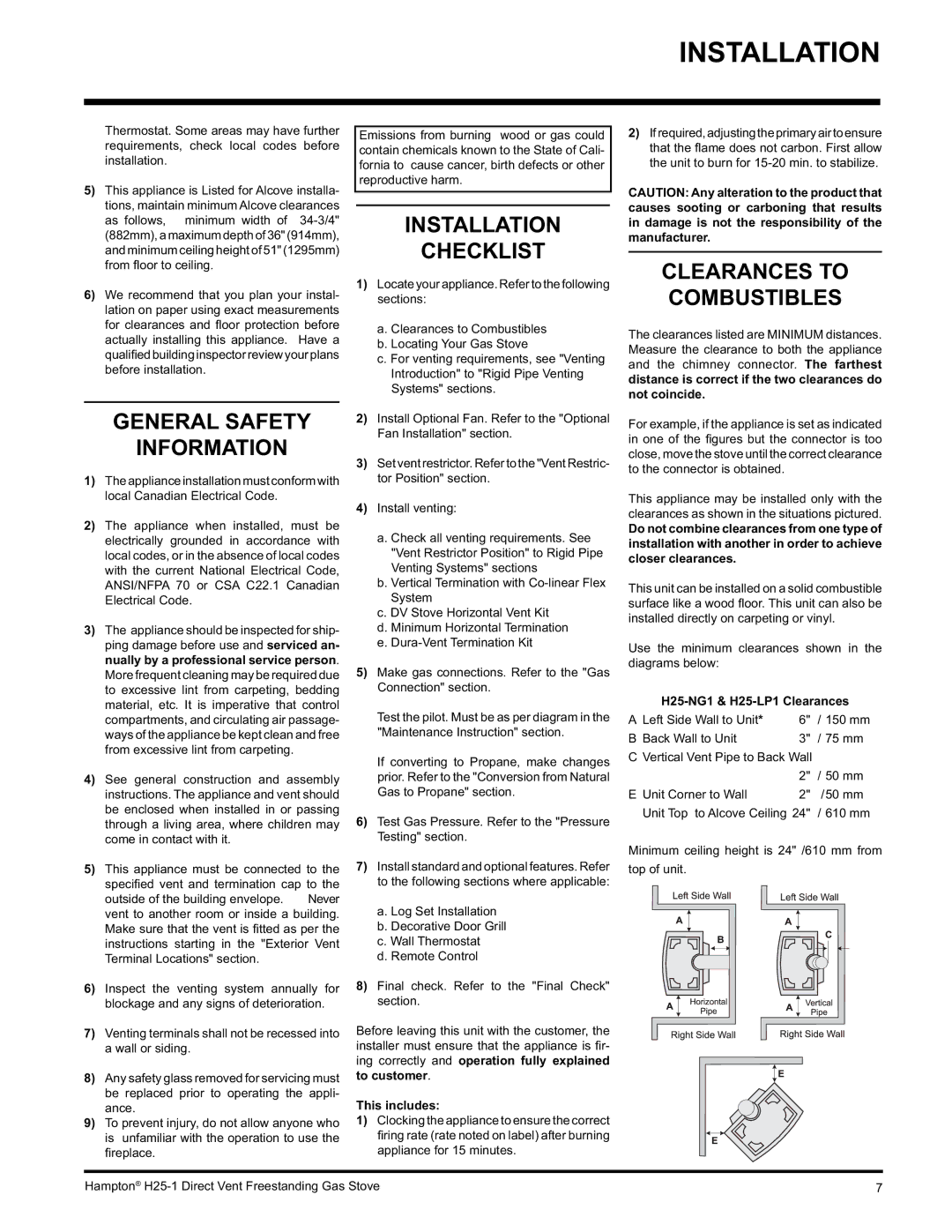
INSTALLATION
Thermostat. Some areas may have further requirements, check local codes before installation.
5)This appliance is Listed for Alcove installa-
tions, maintain minimum Alcove clearances as follows, minimum width of
6)We recommend that you plan your instal- lation on paper using exact measurements for clearances and fl oor protection before actually installing this appliance. Have a qualified building inspector review your plans before installation.
GENERAL SAFETY
INFORMATION
1)The appliance installation must conform with local Canadian Electrical Code.
2)The appliance when installed, must be electrically grounded in accordance with local codes, or in the absence of local codes with the current National Electrical Code, ANSI/NFPA 70 or CSA C22.1 Canadian Electrical Code.
3)The appliance should be inspected for ship- ping damage before use and serviced an- nually by a professional service person. More frequent cleaning may be required due to excessive lint from carpeting, bedding material, etc. It is imperative that control compartments, and circulating air passage- ways of the appliance be kept clean and free from excessive lint from carpeting.
4)See general construction and assembly instructions. The appliance and vent should be enclosed when installed in or passing through a living area, where children may come in contact with it.
5)This appliance must be connected to the specifi ed vent and termination cap to the
outside of the building envelope. Never
vent to another room or inside a building. Make sure that the vent is fi tted as per the instructions starting in the "Exterior Vent Terminal Locations" section.
6)Inspect the venting system annually for blockage and any signs of deterioration.
7)Venting terminals shall not be recessed into a wall or siding.
8)Any safety glass removed for servicing must be replaced prior to operating the appli- ance.
9)To prevent injury, do not allow anyone who is unfamiliar with the operation to use the fi replace.
Emissions from burning wood or gas could contain chemicals known to the State of Cali- fornia to cause cancer, birth defects or other reproductive harm.
INSTALLATION
CHECKLIST
1)Locate your appliance. Refer to the following sections:
a.Clearances to Combustibles
b.Locating Your Gas Stove
c.For venting requirements, see "Venting Introduction" to "Rigid Pipe Venting Systems" sections.
2)Install Optional Fan. Refer to the "Optional Fan Installation" section.
3)Set vent restrictor. Refer to the "Vent Restric- tor Position" section.
4)Install venting:
a.Check all venting requirements. See "Vent Restrictor Position" to Rigid Pipe Venting Systems" sections
b.Vertical Termination with
c.DV Stove Horizontal Vent Kit
d.Minimum Horizontal Termination
e.
5)Make gas connections. Refer to the "Gas Connection" section.
Test the pilot. Must be as per diagram in the "Maintenance Instruction" section.
If converting to Propane, make changes prior. Refer to the "Conversion from Natural Gas to Propane" section.
6)Test Gas Pressure. Refer to the "Pressure Testing" section.
7)Install standard and optional features. Refer to the following sections where applicable:
a.Log Set Installation
b.Decorative Door Grill
c.Wall Thermostat
d.Remote Control
8)Final check. Refer to the "Final Check" section.
Before leaving this unit with the customer, the installer must ensure that the appliance is fi r- ing correctly and operation fully explained to customer.
This includes:
1)Clocking the appliance to ensure the correct fi ring rate (rate noted on label) after burning appliance for 15 minutes.
2)Ifrequired,adjustingtheprimaryairtoensure that the fl ame does not carbon. First allow the unit to burn for
CAUTION: Any alteration to the product that causes sooting or carboning that results in damage is not the responsibility of the manufacturer.
CLEARANCES TO
COMBUSTIBLES
The clearances listed are MINIMUM distances. Measure the clearance to both the appliance and the chimney connector. The farthest distance is correct if the two clearances do not coincide.
For example, if the appliance is set as indicated in one of the fi gures but the connector is too close, move the stove until the correct clearance to the connector is obtained.
This appliance may be installed only with the clearances as shown in the situations pictured.
Do not combine clearances from one type of installation with another in order to achieve closer clearances.
This unit can be installed on a solid combustible surface like a wood fl oor. This unit can also be installed directly on carpeting or vinyl.
Use the minimum clearances shown in the diagrams below:
H25-NG1 & H25-LP1 Clearances
A Left Side Wall to Unit* | 6" | / 150 mm |
B Back Wall to Unit | 3" | / 75 mm |
C Vertical Vent Pipe to Back Wall |
| |
| 2" / 50 mm | |
E Unit Corner to Wall | 2" | /50 mm |
Unit Top to Alcove Ceiling 24" | / 610 mm | |
Minimum ceiling height is 24" /610 mm from
top of unit.
Hampton® | 7 |
